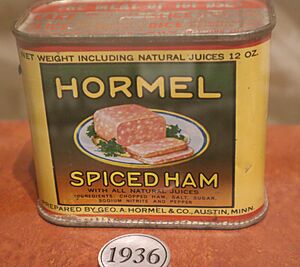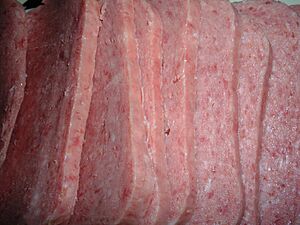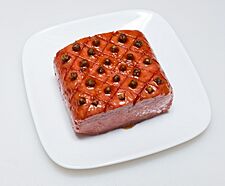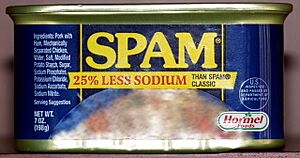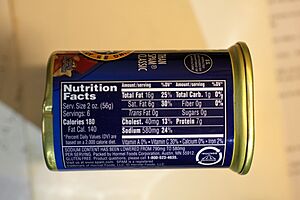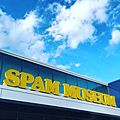Spam (food) facts for kids
 |
|
| Course | Main course or ingredient |
|---|---|
| Region or state | Minnesota |
| Created by | Hormel Foods Corporation |
| Invented | 1937 |
| Serving temperature | Hot or cold |
| Main ingredients | Pork |
| Other information | A precooked canned meat product |
Spam (stylized as SPAM) is a brand of processed canned pork and ham made by Hormel Foods Corporation. It was introduced in 1937 and gained popularity worldwide after its use during World War II. By 2003, Spam was sold in 41 countries (and trademarked in over 100) on six continents.
Spam's main ingredients are pork shoulder and ham, with salt, water, modified potato starch (as a binder), sugar, and sodium nitrite (as a preservative). Natural gelatin is formed during cooking in its tins on the production line. It is available in different flavours, some using different meats, as well as in “lite” and lower-sodium versions. Spam is precooked, making it safe to consume straight from the can, but it is often cooked further for taste.
Concerns about Spam's nutritional attributes have been raised due to the fact that it contains twice as much of the daily dietary recommendation of fat as it does of protein, and about the health effects of salt and preservatives.
Spam has become part of popular culture, including a Monty Python sketch, which repeated the name many times, leading to its name being borrowed to describe unsolicited electronic messages, especially email. It is occasionally celebrated in festivals such as Austin's Spamarama.
Contents
History
Hormel introduced Spam on July 5, 1937. The Oxford Encyclopedia of Food and Drink in America states that the product was intended to increase the sale of pork shoulder, a cut which did not sell well.
Ken Daigneau, the brother of a company executive, won a $100 prize that year in a competition to name the new item. Hormel states that the meaning of the name "is known by only a small circle of former Hormel Foods executives," but a popular belief is that the name is a contraction of "spiced ham." It has also been speculated to be an acronym for "shoulder of pork and ham."
The difficulty of delivering fresh meat to the front during World War II saw Spam become a ubiquitous part of the U.S. soldier's diet. It became variously referred to as "ham that didn't pass its physical," "meatloaf without basic training," and "Special Army Meat." Over 150 million pounds (75,000 short tons) of Spam were purchased by the military before the war's end. Despite this disparagement, throughout the war, countries ravaged by the conflict and faced with strict food rations came to appreciate Spam.
During World War II and the occupations that followed, Spam was introduced into Guam, Hawaii, Okinawa, the Philippines, and other islands in the Pacific. Immediately absorbed into native diets, it has become a unique part of the history and effects of U.S. influence in the Pacific islands. As a consequence of World War II rationing and the Lend-Lease Act, Spam was sold in the United Kingdom. British Prime Minister Margaret Thatcher later referred to it as a "wartime delicacy." In addition to increasing production for the U.K., Hormel expanded Spam output as part of Allied aid to the Soviet Union. In his memoir Khrushchev Remembers, Nikita Khrushchev declared: "Without Spam, we wouldn't have been able to feed our army."
The billionth can of Spam was sold in 1959, and the eight billionth can was sold in 2012.
International usage
United States and territories
Domestically, Spam's chief advantages were affordability, accessibility, and extended shelf life. Statistics from the 1990s say that 3.8 cans of Spam were consumed every second in the United States, totaling nearly 122 million cans annually. It became part of the diet of almost 30% of American households, perceived differently in various regions of the country. It is also sometimes associated with economic hardship because of its relatively low cost.
Spam that is sold in North America, South America, and Australia is produced in Austin, Minnesota (also known as "Spam Town USA") and in Dubuque, Iowa. Austin, Minnesota also had a restaurant with a menu devoted exclusively to Spam called "Johnny's SPAMarama Menu."
Hawaii
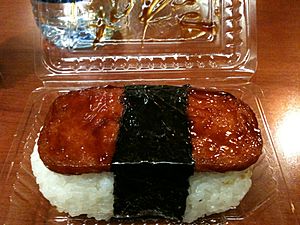
Residents of the state of Hawaii have the highest per capita consumption in the United States, bringing in sales of 7 million cans of Spam per year. Its perception there is very different from that on the mainland. Hawaiians sometimes call it "Portagee Steak".
A local dish in Hawaii is Spam musubi, in which cooked Spam is placed on top of rice and wrapped in a band of nori, a form of onigiri or riceball. Varieties of Spam are found in Hawaii and Saipan that are unavailable in other markets, including Honey Spam, Spam with Bacon, and Hot and Spicy Spam.
Hawaiian Burger King restaurants began serving Spam in 2007 to compete with the local McDonald's chains (which also serve Spam). In Hawaii, Spam is so popular that it is sometimes referred to as "The Hawaiian Steak". There is even an annual Spam-themed festival on the island of Oahu each spring, known as the "Waikiki Spam Jam". Local chefs and restaurants compete to create new Spam-themed dishes, which are then sold in a massive street fair on Kalakaua Avenue in Waikiki.
Guam and the Northern Marianas
In Guam, the average per capita consumption is 16 tins (cans) per year. It is also found on McDonald's menus there. The Spam Games also occur in Guam, where locals sample and honor the best original, homemade Spam recipes.
In the Northern Mariana Islands, lawyers from Hormel have threatened to sue the local press for publishing articles alleging ill effects of high Spam consumption on the health of the local population.
Puerto Rico
Sandwich de Mezcla is a party staple in Puerto Rico containing Spam, Velveeta, and pimientos (made into a spread) between two slices of sandwich bread.
Europe
United Kingdom
After World War II, Newforge Foods, part of the Fitch Lovell group, was awarded the license to produce the product in the U.K. at its Belle Vale factory, Liverpool, where it stayed until production switched to the Danish Crown Group (owners of the Tulip Food Company) in 1998.
The United Kingdom has adopted Spam into various recipes. For example, recipes include Spam Yorkshire Breakfast, Spamish Omelette, and Spam Hash. Spam can also be sliced, battered and deep-fried into Spam fritters.
Middle East
Israel
Loof, a canned corned beef product often featured in Israeli Defense Forces rations, was popularly known as "kosher spam", because it contains no pork.
Asia
Philippines
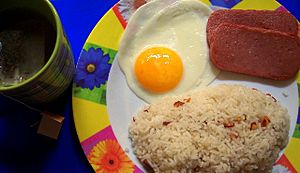
In the Philippines, Spam (currently distributed by the Purefoods-Hormel Company Inc.) is a popular food item seen as a cultural symbol. Spam reached the islands similarly as it did other former US colonies such as Hawaii and Guam: as a result of World War II rationing. Spam is commonly eaten with rice (usually garlic fried rice) and a sunny-side-up egg for breakfast. It is prepared and used in a variety of ways, including being fried, caramelized, served with condiments, or in sandwiches. It has also been featured in numerous Filipino fusion cuisine dishes, including Spam burgers, Spam spaghetti, and Spam nuggets.
The popularity of Spam in the Philippines transcends economic class, and the canned product is even given during holidays. There are at least ten different varieties of Spam currently available in the country, and an estimated 1.25 million kilos of the meat is sold every year in the Philippines. Its popularity among Filipinos has led to the creation of a version with sugar and annatto—Tocino-flavor Spam, made for the overseas Filipino market in the US and Canada. During the rescue efforts after Typhoon Ondoy (Ketsana) in 2009, Hormel Foods donated over 30,000 pounds of Spam to the Philippine National Red Cross.
China
In mainland China, Hormel decided to adopt a different strategy to market Spam (Chinese: 世棒; pinyin: Shìbàng), promoting it as a foreign, premium food product and changing the Spam formula to be meatier to accommodate local Chinese tastes. Spam-like canned pork products are also produced by other food companies in China as "Luncheon Meat" (Chinese: 午餐肉; pinyin: Wǔcānròu; Jyutping: Ng5 caan1 juk6; Zhuyin Fuhao: ㄨˇ ㄘㄢ ㄖㄡˋ).
South Korea
Spam was widely consumed within South Korea during the Korean War, and its popularity led to the creation of the Spam kimbap (rice and vegetable filled seaweed roll) in Korean cuisine. Because of a scarcity of fish and other traditional kimbap products such as kimchi or fermented cabbage, Spam was added to a rice roll with kimchi and cucumber and wrapped in seaweed. US soldiers also used spam in South Korea as a means of trading for items, services, or information around their bases.
In South Korea, Spam (Hangul: 스팸; RR: seupaem, licensed from Hormel by CJ CheilJedang) is popular with a majority of the population. As of 2004[update], South Korea produced and consumed more Spam than any other country except the United States.
Spam is also an original ingredient in budae jjigae (부대찌개; literally "army base stew"), a spicy stew with different types of preserved meat or kimchi, etc.
Hong Kong
After World War II, meat was scarce and expensive in Hong Kong, so Spam was an accessible, affordable alternative. The luncheon meat has been incorporated into dishes such as macaroni with fried egg and spam in chicken soup, as well as instant ramen. Nowadays, Spam remains a staple in Hong Kong’s low to middle-income families. The can of meat can be regularly seen in cafes and small restaurants.
Japan
In Okinawa, Japan, the product is added into onigiri alongside eggs and used as a staple ingredient in the traditional Okinawan dish chanpurū, and a Spam burger is sold by local fast food chain Jef. For the 70th anniversary of Spam in 2007, cans with special designs were sold in Japan due to its popularity, primarily in Okinawa. Following the March 2011 earthquake, Spam sales in Japan declined, and Hormel shifted its focus to China, although Hormel did pledge to donate $100,000 along with cans of Spam for relief efforts.
In early 2014, Burger King introduced the Spam and Cheese burger as a breakfast menu item.
Nutritional data
The ingredients of Spam vary according to variety and market; those of variety "Spam Classic" are pork with ham, salt, water, modified potato starch, sugar, and sodium nitrite.
| Substance | Quantity per 100g serving |
|---|---|
| Energy | 1,300 kJ (310 calories or kilocalories) |
| Protein | 13g (26% daily value or DV) |
| Total fat | 27g (41% DV) |
| of which: saturated fat | 10g (49% DV) |
| Carbohydrates | 3g (1% DV) |
| Sodium | 1369 mg (57% DV) |
| Cholesterol | 70 mg (23% DV) |
| Vitamins and minerals (% DV) | 1% vitamin C, 1% calcium, 5% iron, 3% magnesium, 9% potassium, 12% zinc, and 5% copper |
| Net weight per package: 340 grams (12 oz.) | |
Varieties
The official Spam website lists numerous different flavors of Spam products. In addition to the variety of flavors, Spam is sold in tins smaller than the standard twelve-ounce (340 g) size. Spam Singles are also available, which are single sandwich-sized slices of Spam Classic or Lite, sealed in retort pouches.
Images for kids
-
Former Spam Museum in Austin, Minnesota
-
Facade of new Spam Museum
See also
 In Spanish: Spam (alimento) para niños
In Spanish: Spam (alimento) para niños



